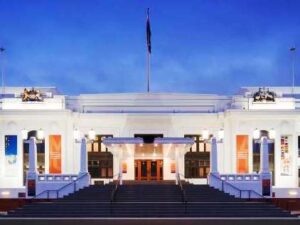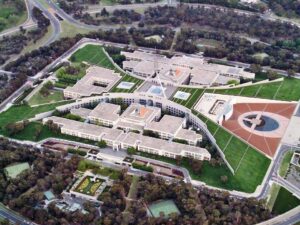» posted on Friday, July 29th, 2022 by Linda Lou Burton
Nothing Like It
Originally Published July 29, 2020 by Linda Lou Burton posting about Canberra, Australia from Little Rock, Arkansas – I’m a sucker for capitol buildings – on the Journey Across America I always dug into the story of how each state’s capitol came to be; the reasons for the choices made in design, location, and symbols. So natch, the story of Australia’s Parliament House was the first thing I wanted to dig into when I woke up in Canberra this morning (on my NDI RTW). Here’s the story straight from the Australian Government website. https://www.aph.gov.au/
Canberra Has Had Two Parliament Houses
 Old Parliament House started life in a rather temporary status. It was named the Provisional Parliament House when government moved from Melbourne to the new capital of Canberra in 1927, designed to serve the needs of Parliament for a maximum of 50 years. It was built in a “Stripped” Classical style common to the 20s and 30s in Australia – no columns or pediments, but the symmetry associated with neoclassical architecture.
Old Parliament House started life in a rather temporary status. It was named the Provisional Parliament House when government moved from Melbourne to the new capital of Canberra in 1927, designed to serve the needs of Parliament for a maximum of 50 years. It was built in a “Stripped” Classical style common to the 20s and 30s in Australia – no columns or pediments, but the symmetry associated with neoclassical architecture.
By the 1970s the building had exceeded its capacity and was in need of considerable repair and renovation, so plans for a new Parliament House began. The new building was opened by Queen Elizabeth II in May 1988. I don’t know what the Queen thought about it, but it’s safe to say there is nothing like it anywhere else in the Commonwealth, or for that matter, the world. Its roof is covered in grass, and the shape is, well – two boomerangs. No kidding, look at the aerial view. See the curves? And that flagpole on top is 266 feet high, weighs 275 tons, and flies a flag that is 42 x 21 feet, about half the size of a tennis court. To the right is the forefront and verandah of the building, where the public is welcomed in; a 640 sq foot mosaic by an Aboriginal artist depicts ancient western desert dreaming.
 But the Old Parliament House wasn’t left out; some of the facades of the New included deliberate imitation of some patterns of the Old, so that there is a slight resemblance despite the massive difference of scale. And the Old still stands today; at the base of Capital Hill at the centre of the Parliamentary Triangle, which is the heart of Walter Burley Griffin’s design for the city of Canberra. (More about the city’s design in the next post.)
But the Old Parliament House wasn’t left out; some of the facades of the New included deliberate imitation of some patterns of the Old, so that there is a slight resemblance despite the massive difference of scale. And the Old still stands today; at the base of Capital Hill at the centre of the Parliamentary Triangle, which is the heart of Walter Burley Griffin’s design for the city of Canberra. (More about the city’s design in the next post.)
Here are some numbers to stretch your mind with regard to the scope of the New Parliament House project.
- 320 entries were submitted in the international design competition from which Architects Mitchell/Giurgola & Thorp were chosen
- 7 years were involved in the construction of the new Parliament House
- 10,000 workers were involved in building and fitting out the building
- 300,000 cubic metres of concrete went into the construction of the building
- $1.1 billion AUD was the cost of the new Parliament House
- 79 acres are covered by Parliament House and its landscape setting on Capital Hill
- 4,500 rooms are in Parliament House
- 5,000+ people work in the building when Parliament sits
- 1 million people visit Parliament House annually
- 200 years is how long Parliament House is designed to last
I can only say – it’s worth a trip to Australia just to see this building!
A few words directly from the Parliament House site about the Chambers:
Parliament House is the heart of Australian parliamentary democracy, and one of the most open parliamentary buildings in the world. It was designed to encourage public access and involvement while responding to the Australian climate, landscape, vegetation, and even the quality of the light.
The House of Representatives has 151 members and is the house in which government is formed. The colour scheme of the House Chambers reflects the green associated with British Parliament’s House of Commons and the eucalypt green of the Australian landscape.
The Senate, or upper house, has 76 senators: 12 from each state and two each from the Northern Territory and the Australian Capital Territory. The Senate Chambers reflect the red of British Parliament’s House of Lords and the shades of ochre red in the Australian landscape.
The Members’ Hall lies at the centre of Parliament House and is not open to the public. Inlaid on the first floor is a bronze Federation Star, representing each of the states and mainland territories of Australia; flowing water comes into the Reflective Pool.
https://www.aph.gov.au/Visit_Parliament/Things_to_Do/Take_in_some_history
https://www.aph.gov.au/Visit_Parliament/Things_to_Do/Discover_the_architecture

